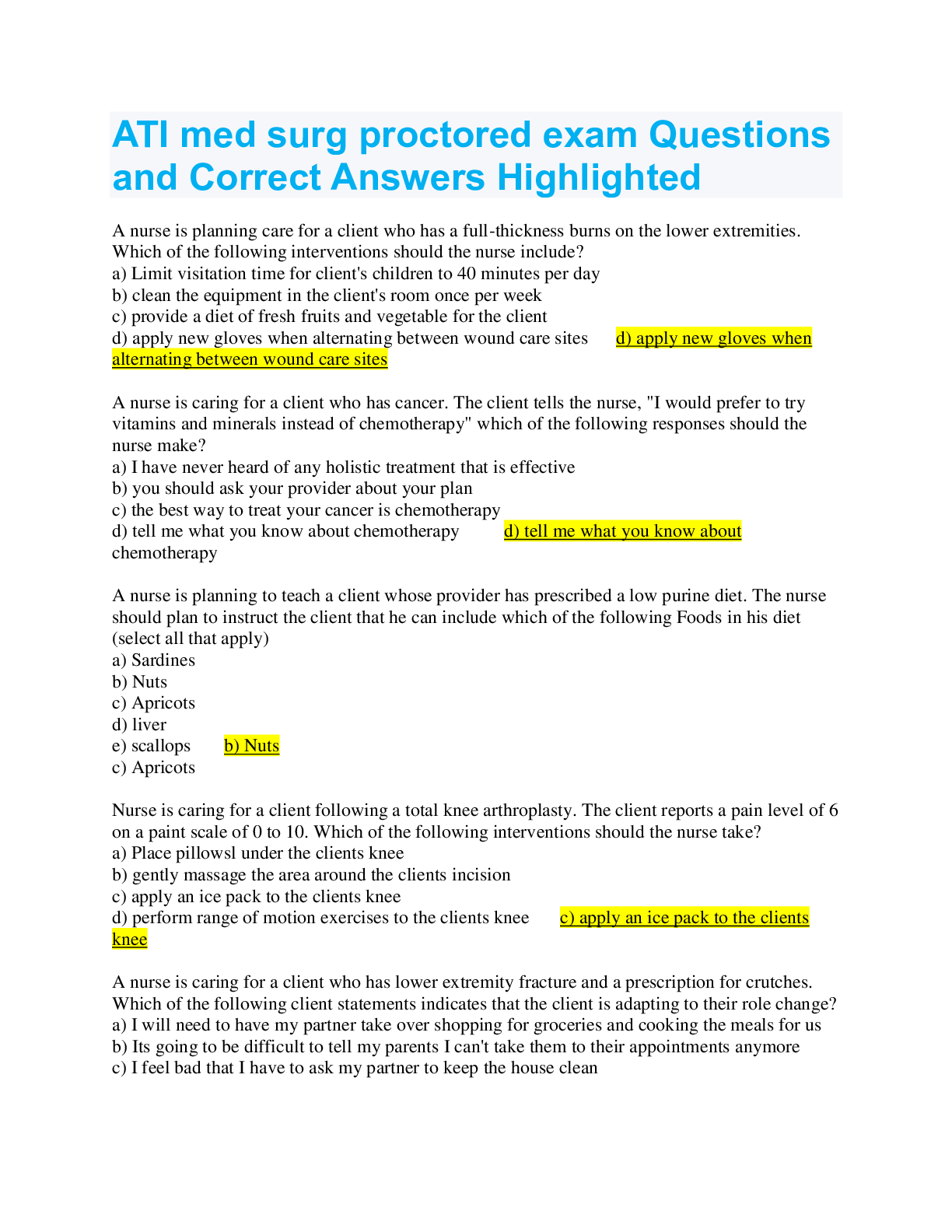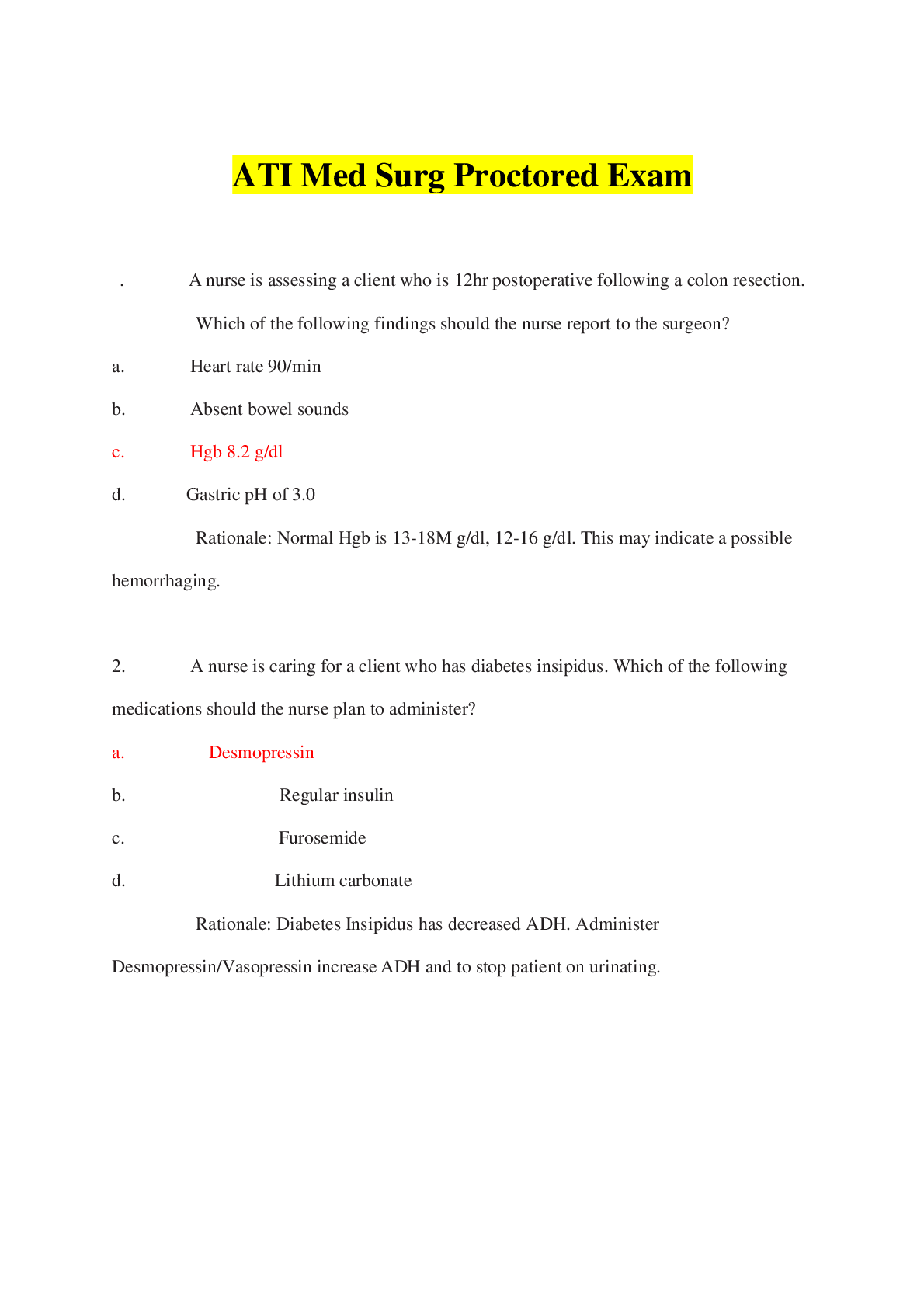*NURSING > ATI MEDICAL SURGICAL > ATI MED SURG PROCTORED EXAM 2023 (All)
ATI MED SURG PROCTORED EXAM 2023
Document Content and Description Below
1.A nurse is assessing a client who is 12hr postoperative following a colon resection. Which of the following findings should the nurse report to the surgeon? 1. Heart rate 90/min 2. Absent bowel soun... ds → normal findings after major bowel surgery; takes several days to return to normal. 3. Hgb 8.2 g/dl 4. Gastric pH of 3.0 Rationale: Normal Hgb is 13-18M g/dl, 12-16 g/dl. This may indicate a possible hemorrhaging. 2. A nurse is caring for a client who has diabetes insipidus. Which of the following medications should the nurse plan to administer? a. Desmopressin b. Regular insulin c. Furosemide d. Lithium carbonate Rationale: Diabetes Insipidus has decreased ADH. Administer Desmopressin/Vasopressin increase ADH and keeps pt. on urinating 3. A nurse is admitting a client who has arthritic pain and reports taking ibuprofen several times daily for 3 years. Which of the following test should the nurse monitor? a. Fasting blood glucose b. Stool for occult blood c. Urine for white blood cells d. Serum calcium Rationale:ATI Pharm 16. Pg. 485 Ibuprofen (NSAIDs) monitor for GI bleed (bloody, tarry stools, abd pain). 4. A nurse in the emergency department is assessing a client. Which of the following actions should the nurse take first (Click on the “Exhibit” button for additional information about the client. There are three tabs that contain separate categories of data.) a. Obtain a sputum sample for culture b. Prepare the client for a chest x-ray c. Initiate airborne precautions d. Administer ondansertron. Rationale: No idea what the Exhibit is all about; wont be able to answer it. 5. A nurse is contacting the provider for a client who has cancer and is experiencing breakthrough pain. Which of the following prescriptions should the nurse anticipate? a. Transmucosal fentanyl b. Intramuscular meperidine c. Oral acetaminophen d. Intravenous dexamethasone Rationale:ATI pg. 27 6. A nurse is admitting a client who reports chest pain and has been placed on a telemetry monitor. Which of the following should the nurse analyze to determine whether the client is experiencing a myocardial infarction? a. PR interval b. QRS duration c. T wave d. ST segment Rationale: ST elevation indicates MI. ST depression indicates ischemia 7. A nurse is teaching a client who has ovarian cancer about skin care following radiation treatment. Which of the following instructions should the nurse include? a. Pat the skin on the radiation site to dry it b. Apply OTC moisturizer to the radiation site c. Cover the radiation site loosely with a gauze wrap before dressing d. Use a soft washcloth to clean the area around the radiation site Rationale: pg. 584. Dry the area thoroughly using patting motions. 8. A nurse is caring for a client who is receiving a blood transfusion. The nurse observes that the client has bounding peripheral pulses, hypertension, and distended jugular veins. The nurse should anticipate administering which of the following prescribed medications? a. Diphenhydramine b. Acetaminophen c. Pantoprazole d. Furosemide Rationale: S/S may indicate fluid retention or heart failure. It is important to administer diuretics to prevent cardiovascular/respiratory distress. 9. A nurse is assessing a client who is receiving magnesium sulfate IV for the treatment of hypomagnesemia. Which of the following findings indicates effectiveness of the medication? a. Lungs clear b. Apical pulse 82/min c. Hyperactive bowel sounds d. Blood pressure 90/50 mm Hg Rationale: ATI p. 494: s/s of hypomagnesemia consist of hypoactive bowel sounds, constipation, paralytic ileus. So effectiveness would indicate opposite of this 10. A nurse is reviewing a client’s ABG results pH 7.42, PaC02 30 mm Hg, and HCO3 21 mEq/L. The nurse should recognize these findings as indication of which of the following conditions? a. Metabolic acidosis b. Metabolic alkalosis c. Compensated respiratory alkalosis d. Uncompensated respiratory acidosis Rationale: because the HCO3 21 trying to compensate for respiratory alkalosis 11. A nurse is caring for a client who has a deep partial thickness burns over 15% of her body which of the following labs should the nurse expect during the first 24 hours A. Decreased BUN ELEVATED DT fluid loss B. Hypoglycemia (High due to stress) C. Hypoalbuminemia (Low due to fluid loss) D. Decreased Hematocrit (Elevated due to 3rd spacing during resuscitation phase) (Page 481 ch 75 med surge ati pdf 10.0) 12. A nurse is caring for a client who has dumping syndrome following a gastrectomy, which of the following actions should the nurse take ? a. Offer the client high carbohydrate meal options (High fat, high protein, low fiber, low to moderate carbs page 317, chapter 49 Peptic ulcer disease med surge ati pdf 10.0) b. Provide the client with four full meals a day (Small frequent meals) c. Encourage the client to to drink at least 360 ml of fluids with meals (Eliminate liquids with meals for 1 hr prior and following a meal) d. Have the client lie down for 30 minutes after meals (Lying down after a meal slows the movement of food within the intestines) 13. A nurse is teaching a group of young adult clients about risk factors for hearing loss. Which of the following factors should the nurse include in the teaching? SATA. (p.70 chapter 13) Born with a high weight Chronic infections of the middle ear Use a loop diuretic Perforation of the ear drum Frequent exposure to low volume noise 14. A nurse is preparing to administer fresh frozen plasma to a client . Which of the following actions should the nurse take? (Chapter 92 page 606 med surge ati pdf 10.0) Administer the plasma immediately after thawing (Blood must be warm, you also have a 30 minute window to give it so bacteria doesn’t grow. So it doesn’t necessarily have to be right away.) Transfuse the plasma over 4 hour (Can be in 2 to 4 hours) Hold the transfusion if the client is actively bleeding (YOU HAVE TO GIVE IT. That’s the whole point! The patient is losing blood so you have to replace it. We give fresh frozen plasma because he or she may have clotting deficiencies) Administer the transfusion through a 24 gauge saline lock (Has to be a 18 or 20 gauge) 15. A nurse is assessing a clients who reports numbness and tingling of his toes and exhibits a positive TROUSSEAU. Which of the following electrolyte imbalance should the nurse suspect? (ch 44 page 277 MS ATI PDF 10.0) Hypoatremia Hyperchloremia Hypermagnesemia Hypocalcemia (low calcium = low ca causes increased firing = spasms. Learned this is LVN school.) 16. A home health nurse is teaching a clients how to care for a peripherally central catheter in his right arm. Which of the following statements should the nurse include in the teaching? (Chapter 27 cardiovascular diagnostics and therapeutic procedures p. 165 MS ATI PDF 10.0) Change the transparent dressing over the insertion site every 48 hours - transparent dressing can be up to 7 days Clean the insertion site with mild soap and water - when showering, [Show More]
Last updated: 1 year ago
Preview 1 out of 35 pages
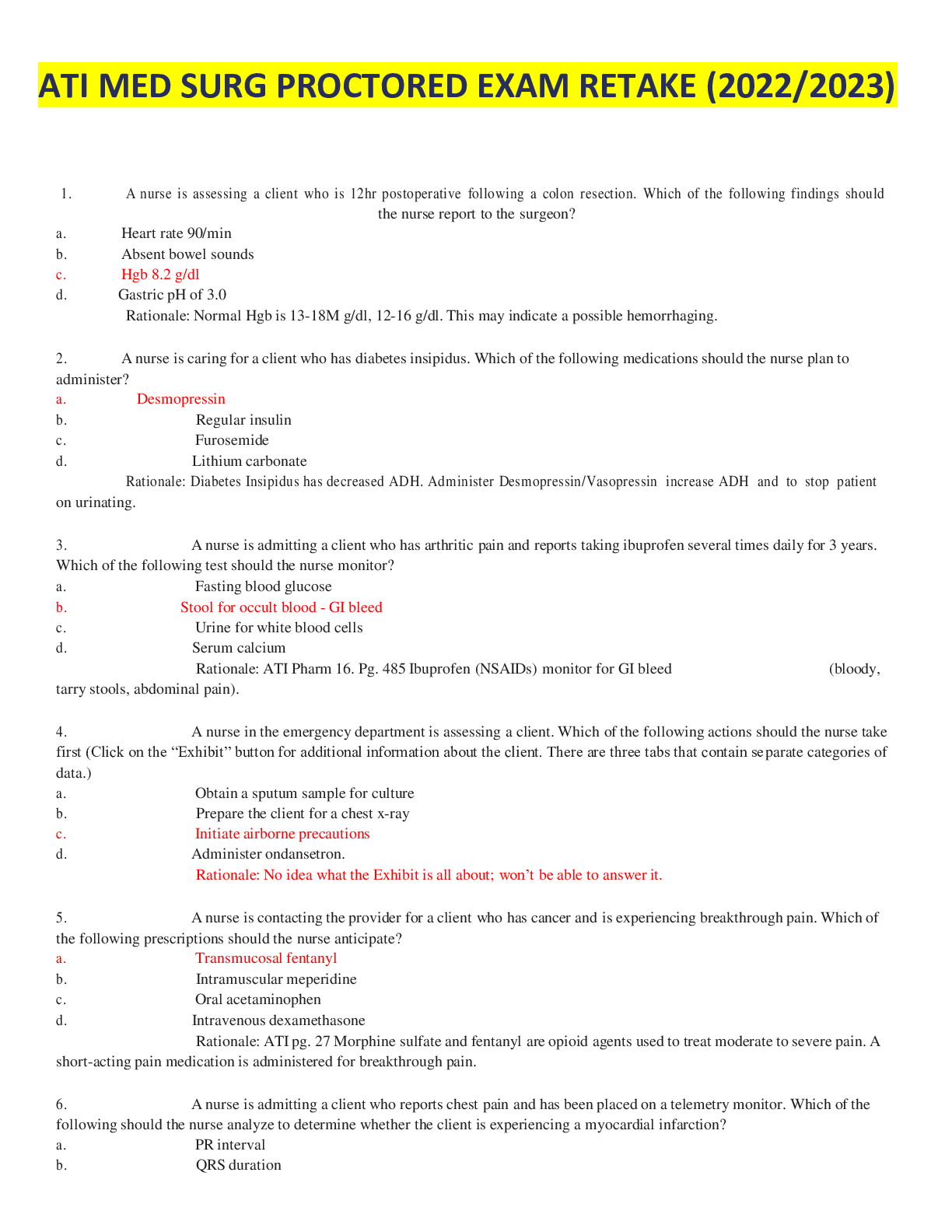
Reviews( 0 )
Document information
Connected school, study & course
About the document
Uploaded On
Apr 16, 2023
Number of pages
35
Written in
Additional information
This document has been written for:
Uploaded
Apr 16, 2023
Downloads
0
Views
93




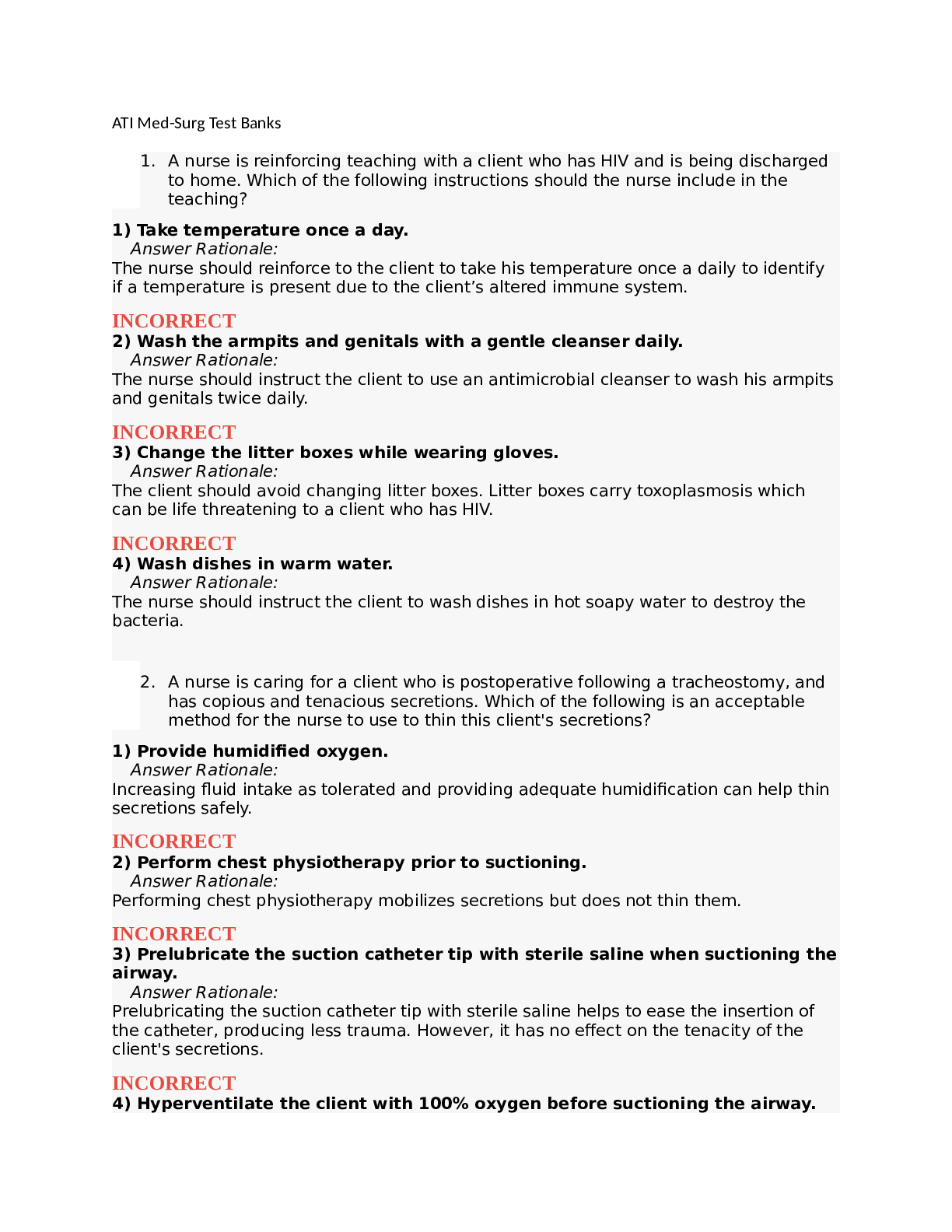
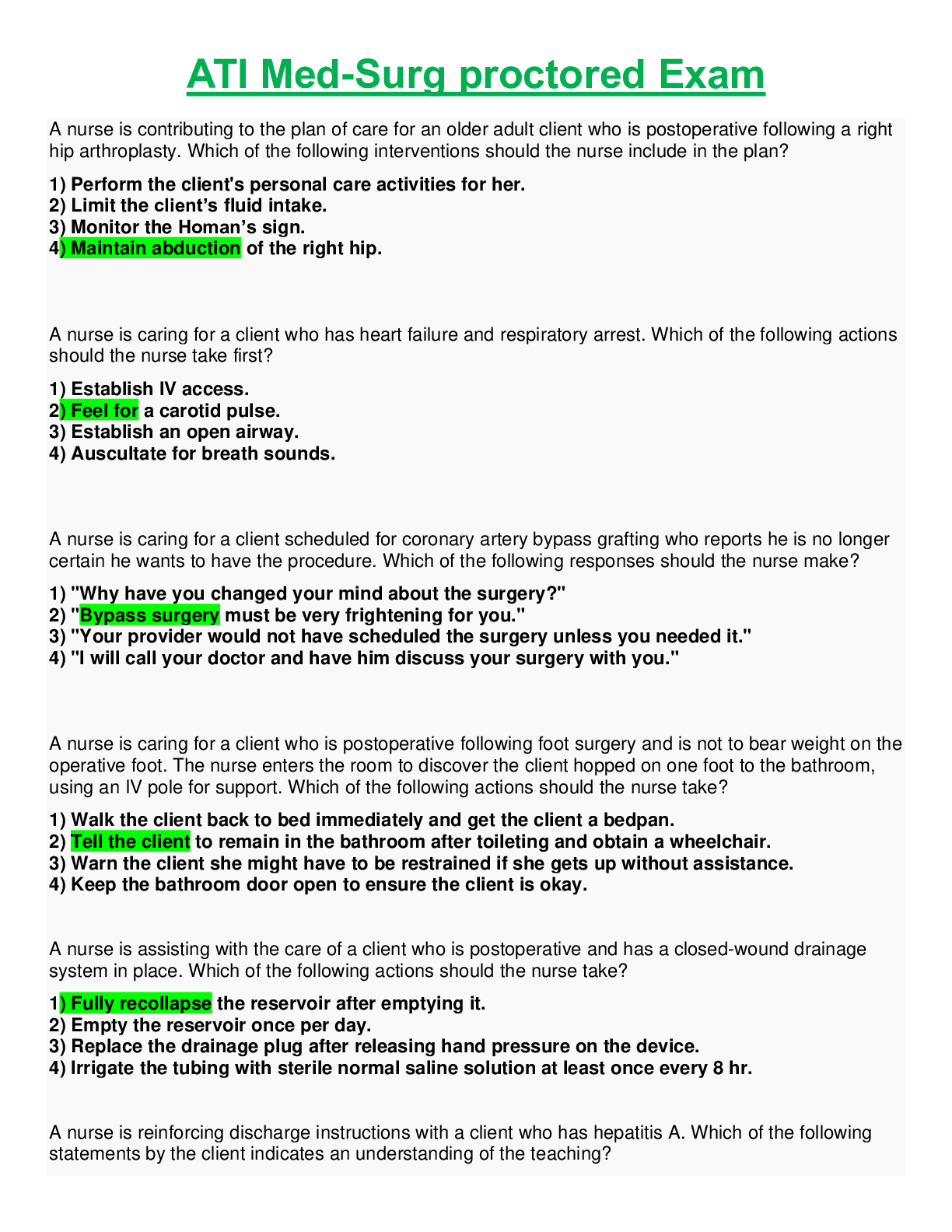

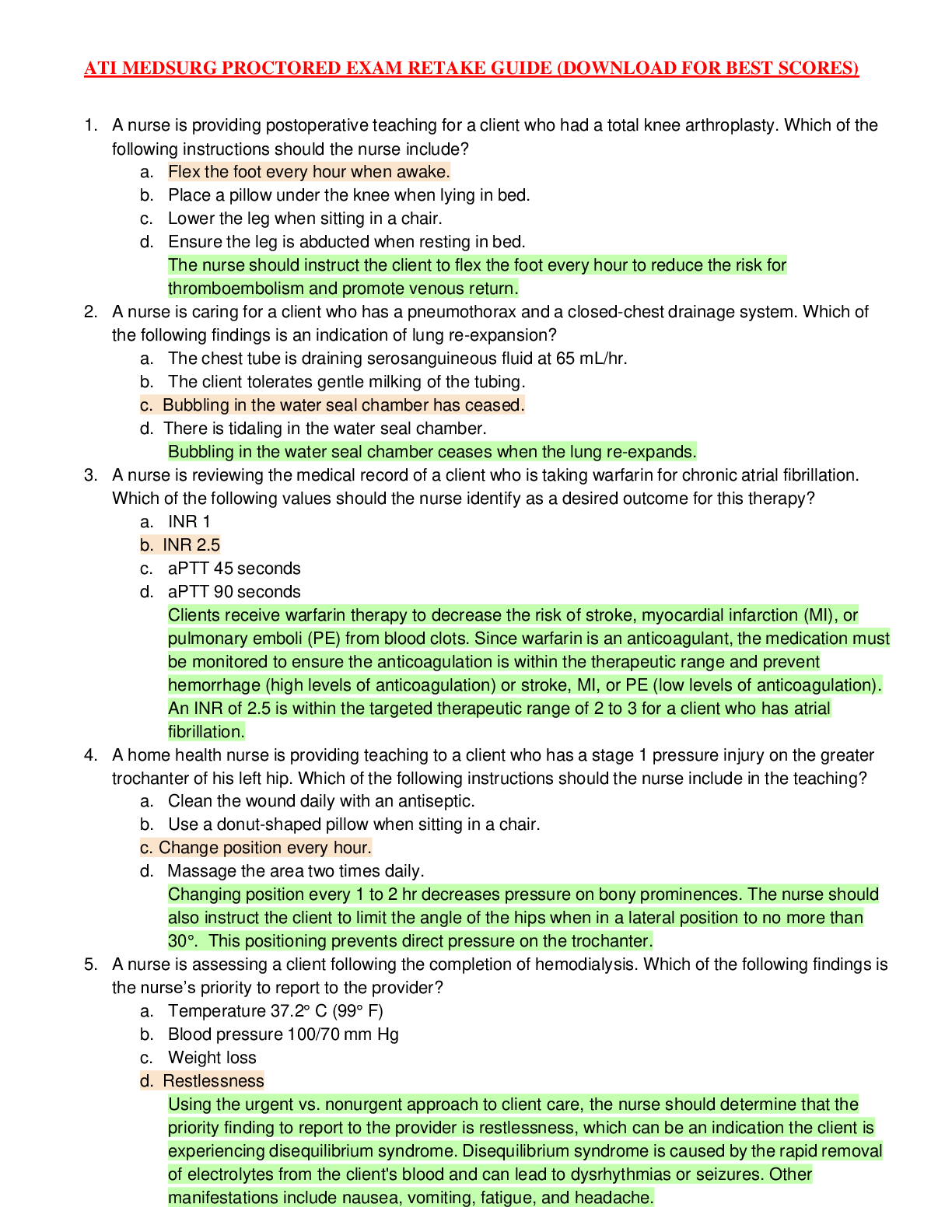

 (2500+ Q & A).png)
